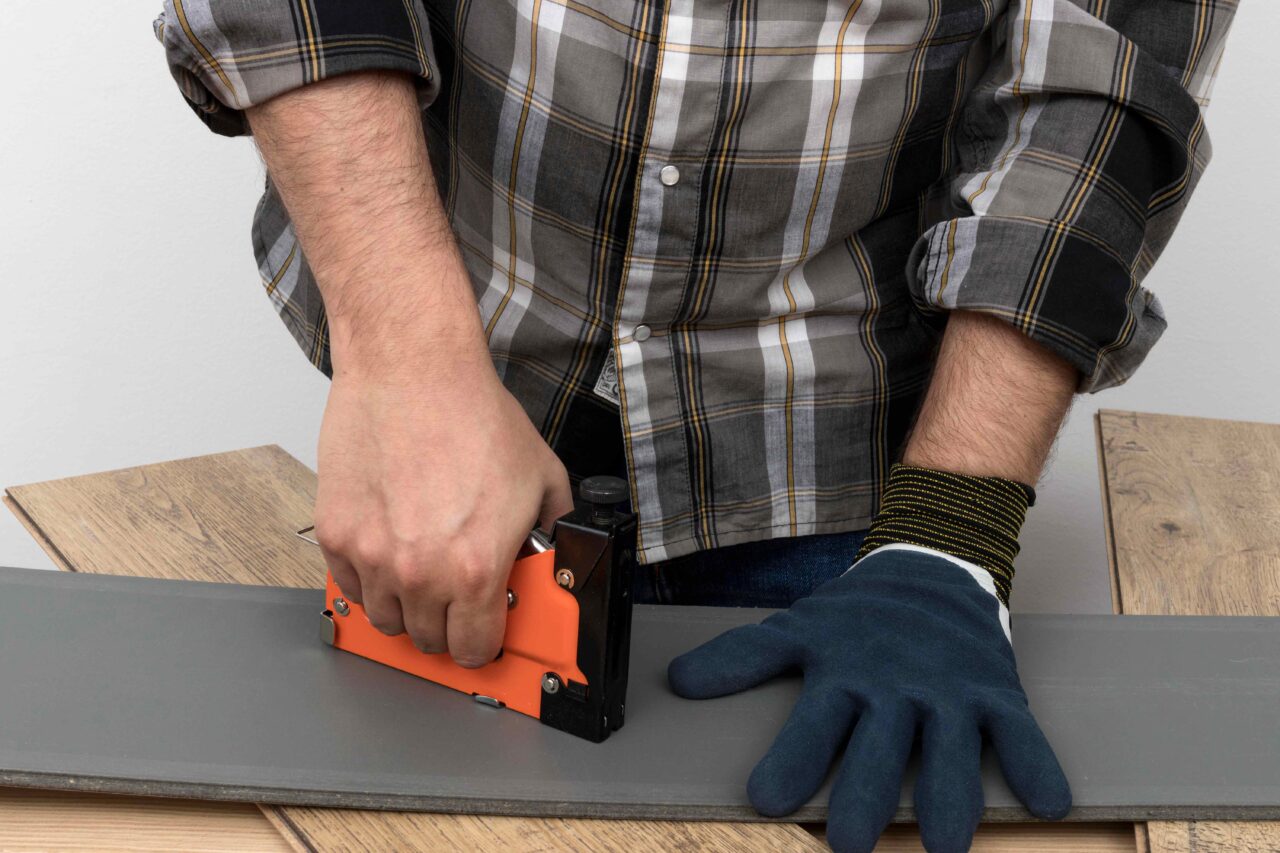This comprehensive guide will dive deep into various flooring installation methods to help you make an informed decision.
Nail Down or Staple Down Installation
The Basics
The nail-down or staple-down method is commonly used for engineered and solid wood flooring. It involves securing the flooring planks to the subfloor using nails or staples. This method provides a stable and secure fit, making it a popular choice among homeowners.
What You’ll Need
You’ll require specialized tools such as floor nailers, staplers, and an air compressor to nail down your flooring. The thickness of your flooring will determine the gauge and length of nails or staples needed.
Installation Process
- Angled Nailing: This method is often called “blind nailing.” To achieve it, you’ll need to angle the nail at approximately 45 degrees into each plank’s tongue, then secure it by driving it through.
- Underlay: It’s crucial to install a thin underlay beneath t blind nailing he planks. This moisture barrier protects your floor from damage over time and eliminates floor creaks and squeaks.
- Subfloor Requirements: Nail-down or staple-down installation works best on a clean, dry, and stable wooden subfloor. If you need more expertise in subfloor preparation, enlisting professionals’ services is advisable.
Pros and Cons
Advantages:
- Creates a stable and secure fit.
- Relatively cost-effective compared to other methods.
- Provides good insulation underfoot.
Disadvantages:
- Limited to wood subfloors.
- Nails may loosen due to seasonal expansion.
- Best installed by professionals for optimal results.
Glue Down Flooring Installation
The Basics
Glue-down flooring installation is commonly used for vinyl flooring. It relies on adhesives to secure the flooring to the subfloor. This method ensures a stable fit but can be more challenging than other methods.
What You’ll Need
The type of subfloor plays a crucial role in the glue-down installation. If your subfloor is wood, you won’t require excessive adhesive. However, concrete subfloors may demand more adhesive due to potential exposure to high moisture levels or reactive chemicals.
Installation Process
- Adhesive Selection: Choosing the correct adhesive is essential for accurate installation. Different types of adhesives with varying chemical compositions are available. Make sure you select the one suited to your subfloor and flooring material.
- Precise Alignment: Ensuring the planks are aligned straight in a row is essential. A dry fit, where planks are temporarily fitted without adhesives, can help identify any adjustments needed for a perfect installation.
Pros and Cons
Advantages:
- It provides a stable fit that won’t shift over time.
- Eliminates the need for a vapor barrier.
- Suitable for various subfloor types.
Disadvantages:
- It is more challenging to install than other methods.
- Difficult to remove for repairs or replacements.
- The installation process can be messy.
Glue-Free Tongue & Groove Floating Installation
The Basics
Floating installation is commonly employed for floors with a High-Density Fiberboard (HDF) core layer using a glue-free tongue and groove system. This layer allows manufacturers to mill tongues and grooves onto the sides of the planks, facilitating easy installation.
What You’ll Need
This installation method doesn’t require adhesives or nails. However, an underlay is necessary for added comfort and sound reduction. It adapts well to various subfloor types, including vinyl, hardwood, or tile, as long as it is clean, dry, stable, and strong.
Installation Process
- Tongue and Groove Connection: Connecting the tongue on one plank with the respective groove in the adjacent plank locks them perfectly in place. This method ensures a seamless look once the installation is complete.
- Underlay Placement: The underlay is placed beneath the floor to add comfort and reduce sound.
Pros and Cons
Advantages:
- Fast and easy installation method suitable for DIY enthusiasts.
- Cost-effective.
- Easy to remove or repair damaged planks.
Disadvantages:
- Planks may require more frequent replacement.
- Incorrect installation may amplify sound.
- Sanding the floor down is not possible with this method.
Click System Installation
The Basics
Click system installation is one of the easiest methods available. It’s commonly found in Luxury Vinyl Tile (LVT) flooring but is also used in laminate and newer engineered wood flooring. This method allows planks or tiles to simply click together without needing glue, nails, or screws.
What You’ll Need
Click system installation is typically done over an underlay. Unlike some other methods, it doesn’t require specialized tools or adhesives. It’s so user-friendly that anyone can do it, making it a favorite for DIY enthusiasts.
Installation Process
- Plank Connection: Planks or tiles are designed with interlocking mechanisms. You simply click them together until they fit closely, eliminating unsightly gaps.
- Underlay Placement: As with many flooring methods, installing the flooring over an underlay is essential for added comfort and sound insulation.
Pros and Cons
Advantages:
- Quick and easy installation method suitable for beginners.
- It can be installed by homeowners without specialized skills.
- Produces a tight, secure fit without the need for additional materials.
Disadvantages:
- It requires a solid base and is not suitable for installation over joists.
Each flooring product will specify the recommended installation method.
Consider Your Priorities
Ease of Installation: If you’re a DIY enthusiast looking for a quick and easy installation process, click system floors are highly recommended.
- Stability: If you prioritize stability and are willing to hire professionals for installation, you can opt for nail or glue-down flooring.
- Subfloor Type: Ensure your chosen method is compatible with your subfloor type.
By assessing your main priorities in terms of installation, you can select the flooring method that best suits your requirements. Whether aiming for a DIY project or seeking professional assistance, understanding the installation process is critical to achieving the perfect floor for your space.
Conclusion
Choosing the correct flooring installation method is critical in your home improvement journey. Each method has advantages and disadvantages, making considering your specific needs and preferences essential.
Transform your home effortlessly with FloorPup! Discover our extensive range of hardwood flooring, receive tips from expert floor care and maintenance professionals. Our team includes professional floor fitters, skilled driveway pavers, and dependable carpet repair specialists, ensuring top-notch results. Learn more about our dedication to quality on our About Us page. Visit FloorPup and start enhancing your living space today!
FAQS
What is the best method of floor installation?
The ideal method for floor installation varies based on factors such as the flooring material and project requirements. Options include floating, glue-down, nail-down, and click-and-lock installations. For instance, floating is well-suited for engineered wood or laminate, while glue-down works best for hardwood. Consulting a flooring professional is crucial to determine the most suitable installation method for your needs.
What are the steps for flooring?
Have you ever wondered about the steps for flooring installation? It starts with preparing the subfloor and then measuring and planning the layout. Afterward, apply adhesive or underlayment, then carefully lay and fit the flooring material, securing it firmly in place. Finally, finishing touches like molding or trim are added. Each step requires precision and attention to detail to ensure a flawless and durable flooring outcome.
What are the methods of installing wood floors?
Installing wood floors involves several methods. Standard techniques include nail-down, where planks are secured to the subfloor with nails or staples, and glue-down, which uses adhesive to attach the wood directly to the subfloor. And floating installations, planks interlock and “float” over an underlayment without direct subfloor attachment. Your choice depends on wood type, subfloor conditions, and personal preference.
What is installed flooring?
What is installing flooring? It’s placing various floor coverings like hardwood, tile, laminate, or carpet in homes or businesses. This procedure includes preparing the subfloor, measuring, cutting, and properly putting in the flooring material to create a level, sturdy, and visually beautiful floor. You may hire experts or do it yourself if you possess the needed expertise and tools.


